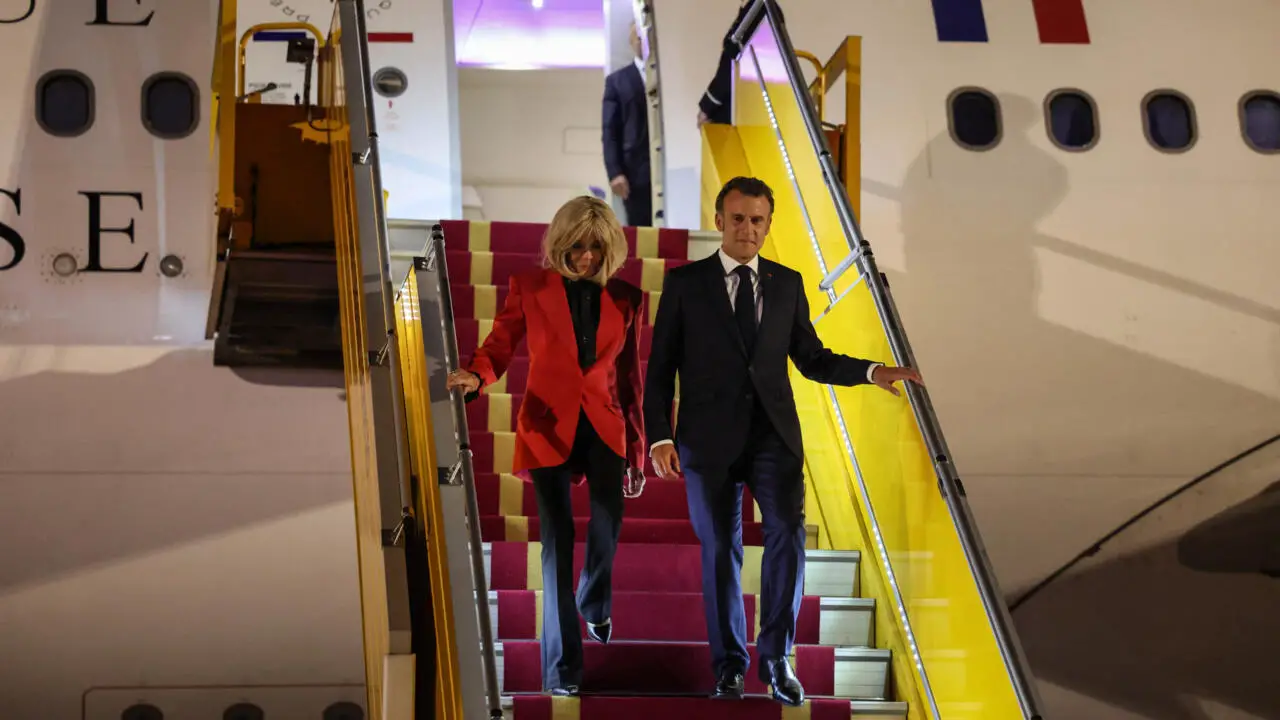French President Emmanuel Macron and his wife, Brigitte, found themselves at the center of social-media frenzy late last month after video footage appeared to show Brigitte Macron delivering a sharp push—or what many viewers interpreted as a slap—to her husband’s face upon disembarking their plane in Hanoi. The exchange, captured by Associated Press cameras as the presidential couple arrived in Vietnam on 25 May, quickly went viral, inspiring everything from snarky memes to impassioned debates about the nature of their relationship.
Behind the headlines and the countless retweets lies a nuanced story—one that defies simplistic readings of marital strife or public humiliation. In the days following the incident, Jesús Enrique Rosas—known online as “The Body Language Guy”—offered a frame-by-frame analysis of the couple’s body language. His detailed breakdown, which he published in a seven-tweet thread on X (formerly Twitter), suggests that what looked like hostility may have been little more than playful horsing around, exaggerated by the glare of international scrutiny.
The Contested Moment in Hanoi
As President Macron, 47, and Brigitte Macron, 72, prepared to step onto the tarmac in Vietnam, the pair paused in the doorway of their aircraft. At that instant, Brigitte’s right arm shot forward, making contact with her husband’s face and forcing his head slightly backward. Macron’s expression shifted from neutral to startled, and he instinctively raised his left hand to steady himself against the nearby fuselage. Only seconds later did the couple proceed side by side down the stairs, their composure brushing aside the abrupt motion.
Viewers around the world seized on the clip, speculating on everything from a sudden disagreement to evidence of deep marital tension. Comment threads exploded with questions: Had Brigitte lost her temper? Was Emmanuel publicly embarrassed? Or was this merely a moment misinterpreted by fast-moving footage and sensational headlines?
A Body-Language Expert Weighs In
Enter Jesús Enrique Rosas, whose online moniker “The Body Language Guy” belies his serious approach to nonverbal communication analysis. Rosas’s central claim rests on two main observations:
Unanticipated Gesture
Pre-Gesture Baseline: In the split second before Brigitte’s arm swung, Macron exhibited a relaxed posture—his facial muscles at rest, his left wrist limp. According to Rosas, a truly aggressive shove would have elicited a more guarded stance or anticipatory shift in Macron’s body language.
Instant Reaction: Macron’s surprise is evident in his quick pivot of the head and the “anchor” gesture—placing his left hand on the plane’s seat cushion without applying weight, a classic stress response.
Dual-Hand “Shovelling”
While many described the motion as a slap, Rosas notes that Brigitte actually used both hands to guide Macron’s head backward—more a “shovelling” than an open-palm strike. At the peak of the gesture, Macron is acutely aware of on-lookers and cameras, prompting a rapid shift to diplomatic greeting mode.
Rosas’s thread then traces the couple’s subsequent body language: Macron’s brief nose-touching pacifier gesture, Brigitte’s decision not to take her husband’s offered arm on the staircase, and Macron’s choice of a “dominant” palm-down handshake with his welcoming official. Each detail, he argues, points toward a scenario in which the Macrons were play-fighting rather than exchanging genuine hostility.
Official Responses and Context
In the wake of the viral clip and Rosas’s social-media analysis, Élysée Palace spokespeople sought to defuse the spectacle. President Macron himself told reporters, “We are horsing around and, really, joking with my wife,” as reported by France24. His office echoed that sentiment in an official statement, describing the exchange as “a moment of complicity” and lamenting that “it’s all the conspiracy theorists needed for fresh ammunition.”
Observers note that Brigitte and Emmanuel Macron, despite their 25-year age difference, have long displayed a public camaraderie: shared laughter during official visits, affectionate gestures at state functions, and mutual support in high-pressure moments. Far from strangers to the world stage, they adeptly manage both political optics and personal rapport, making it entirely plausible that the Hanoi episode was simply an impromptu, lighthearted interaction amplified by the immediacy of digital media.
Decoding Public Couples’ Nonverbal Signals
The Macrons’ incident provides a textbook example of how nonverbal cues can be magnified—and often misread—in today’s hyper-connected environment. A few key takeaways:
Baseline Matters: Establishing an individual’s neutral posture before an event helps distinguish between a genuine aggressive move and an unexpected but benign gesture.
Context Over Clip: A two-second video can never capture the lead-in or aftermath. What precedes and follows an interaction is crucial to understanding intent.
Stress Signals vs. Hostile Signals: Subtle “anchor” gestures (touching a wall, handrail, or seat) often signal surprise or insecurity—not necessarily anger.
Power Poses Afterward: A later dominant handshake or upright posture can indicate a desire to reassert authority or composure, particularly in public figures.
Body-language analysis, while insightful, remains interpretive rather than definitive. Expert observers—including Rosas—acknowledge that such readings must be tempered by cultural nuances, individual habits, and the broader relational history between two people.
What This Means for Diplomatic Media
For journalists, analysts, and curious followers of global politics, the viral “slap” moment underscores a broader lesson about media consumption: snippets of video, freed from context, can fuel rapid misinterpretation and public rumor. While sensational headlines may drive clicks and engagement, they risk distorting reality and generating needless controversy.
In response, several leading news outlets have updated their coverage to emphasize the couple’s official explanation and the insights of body-language specialists. The result is a more measured narrative that balances the intrigue of a spontaneous moment with the Macrons’ well-documented rapport and good humor.
Conclusion
The footage of Brigitte Macron’s sudden push to her husband’s face will undoubtedly remain one of 2025’s more memorable viral moments—but its true significance extends beyond a single unexpected gesture. It highlights the pitfalls of snap judgments in the digital age, the importance of contextual body-language reading, and the resilience of public relationships under relentless media scrutiny.
Ultimately, the Macrons’ exchange serves as a reminder that even the most powerful couples share private dynamics—humor, playfulness, and occasional awkwardness—that can bewilder global audiences when divorced from fuller understanding. Thanks to experts like Jesús Enrique Rosas and the couple’s own clarifying statements, what began as a viral spectacle can now be appreciated as a fleeting, human moment in an otherwise highly choreographed diplomatic visit.
BODY LANGUAGE ANALYSIS OF BRIGITTE SHOVING EMMANUELLE MACRON'S FACE
(1/7) Emmanuel and Brigitte Macron were arriving in Vietnam when the cameras captured this interaction.
But was it an actual, aggressive gesture, or was something else? let's find out… pic.twitter.com/HCMdtBk2nu
— Jesús Enrique Rosas – The Body Language Guy (@Knesix) May 26, 2025

Lila Hart is a dedicated Digital Archivist and Research Specialist with a keen eye for preserving and curating meaningful content. At TheArchivists, she specializes in organizing and managing digital archives, ensuring that valuable stories and historical moments are accessible for generations to come.
Lila earned her degree in History and Archival Studies from the University of Edinburgh, where she cultivated her passion for documenting the past and preserving cultural heritage. Her expertise lies in combining traditional archival techniques with modern digital tools, allowing her to create comprehensive and engaging collections that resonate with audiences worldwide.
At TheArchivists, Lila is known for her meticulous attention to detail and her ability to uncover hidden gems within extensive archives. Her work is praised for its depth, authenticity, and contribution to the preservation of knowledge in the digital age.
Driven by a commitment to preserving stories that matter, Lila is passionate about exploring the intersection of history and technology. Her goal is to ensure that every piece of content she handles reflects the richness of human experiences and remains a source of inspiration for years to come.
